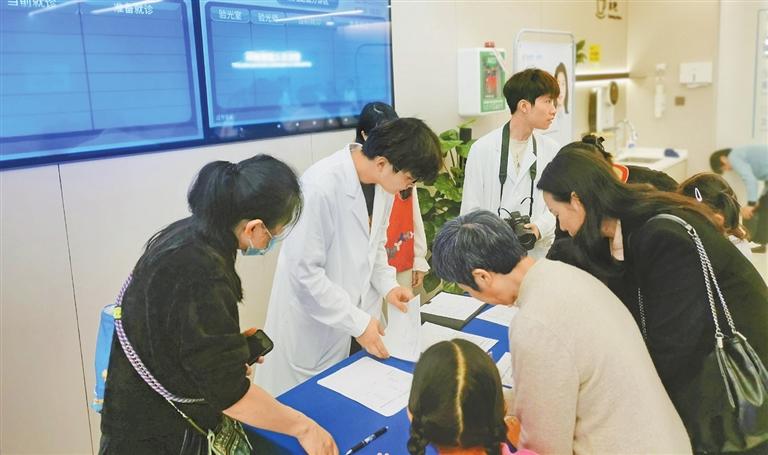

Debra Li debra_lidan@163.com NEARLY a hundred ophthalmologists, local officials, and journalists from Shenzhen, Hong Kong, and other Guangdong Province cities attended the official opening ceremony of Shenzhen Bright Star Eye Hospital yesterday morning. The new facility is the 35th hospital under Bright Eye (known as “Purui” in pinyin), a private hospital chain listed on the ChiNext board. It is the chain’s second hospital in Shenzhen and the first specialized eye hospital in Luohu District. To celebrate its opening, the hospital is offering free eye examinations until the end of this month for children, seniors, and individuals planning to undergo laser surgery for refractive errors. Located in the Tian’an International Building adjacent to the Guomao Metro Station, the hospital spans 15,000 square meters across four floors. It provides specialized treatments for refractive errors caused by myopia, hyperopia, astigmatism, cataracts, ocular fundus diseases, and glaucoma. Equipped with advanced technology such as ZEISS IOLMaster 700 biometric measurement devices and SCHWIND AMARIS laser systems, the hospital also features 80 inpatient beds. Ge Jian, a renowned glaucoma and cataract specialist and former dean of the Zhongshan Ophthalmic Center at Sun Yat-sen University, China’s premier eye hospital, praised the new hospital’s efforts to raise awareness about eye diseases through free screenings. “World Glaucoma Week is observed annually during a week in March, with this year’s event falling between March 9 and 16,” Ge explained. “Often called the ‘sneak thief of sight,’ glaucoma is a leading cause of preventable blindness. Lack of awareness can lead to severe outcomes, including permanent vision loss. Since symptoms often appear only in the late stages, it is crucial to encourage regular eye and optic nerve checks for early detection. Fortunately, treatments are available for all forms of glaucoma.” Ge also explained that individuals with severe myopia, particularly women over 40, are at higher risk of developing glaucoma. He strongly advised against using smartphones in dimly lit environments to reduce eye strain. Liu Quan, a leading specialist at the hospital who focuses on SMILE and other laser eye surgeries, briefed the media on the latest advancements in AI-assisted procedures. “AI is now being used to map the cornea, determine the appropriate size for implantable contact lenses (ICL), and accurately predict the outcomes of various laser surgeries,” he said. Situated near the Luohu checkpoint, the hospital has already attracted patients from neighboring Hong Kong. A Hong Kong driver surnamed Peng recently underwent cataract surgeries on both eyes at the hospital over the past two weeks. Also yesterday, children participated in a one-day “eye doctor” program, where they learned the basics of conducting standard eye examinations and attended a lecture on maintaining healthy eye habits. In addition to public institutions like the Shenzhen Eye Hospital and ophthalmology departments in general hospitals, several private eye hospital chains — such as AIER, Huaxia, and C-Mer Dennis Lam Eye Hospital — have established facilities in Shenzhen. According to a report by huaon.com, a Chinese market research platform, the eye care services market was valued at 158 billion yuan (US$21.8 billion) in 2022 and is expected to continue growing. Since opening its first hospital in Lanzhou in 2005, the Bright Eye Hospital chain has expanded to 35 locations in 24 Chinese cities. | 
